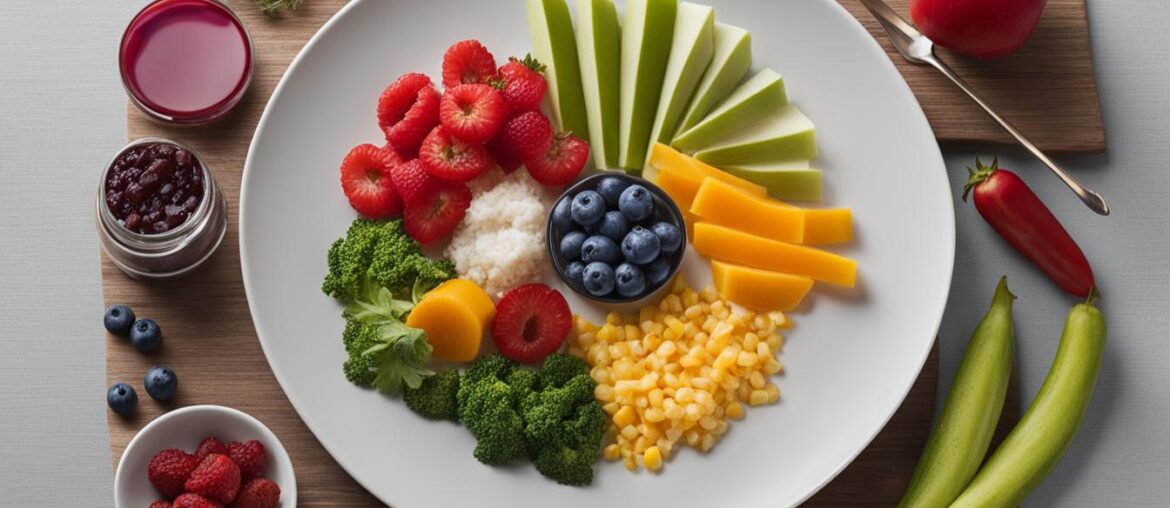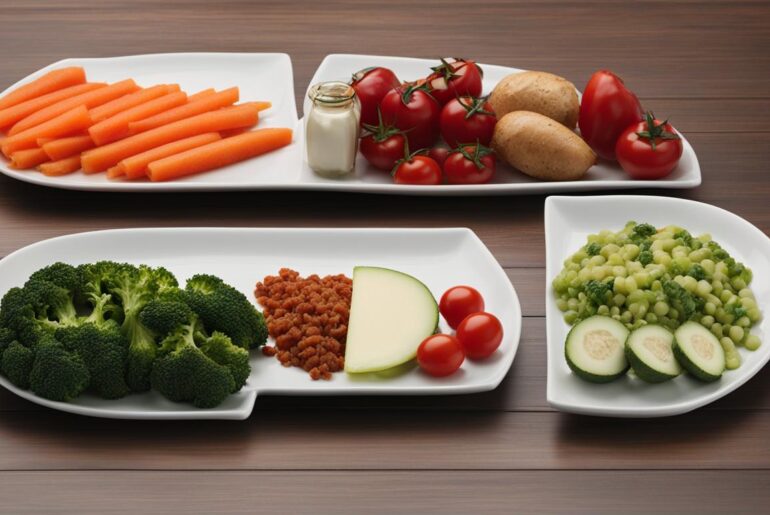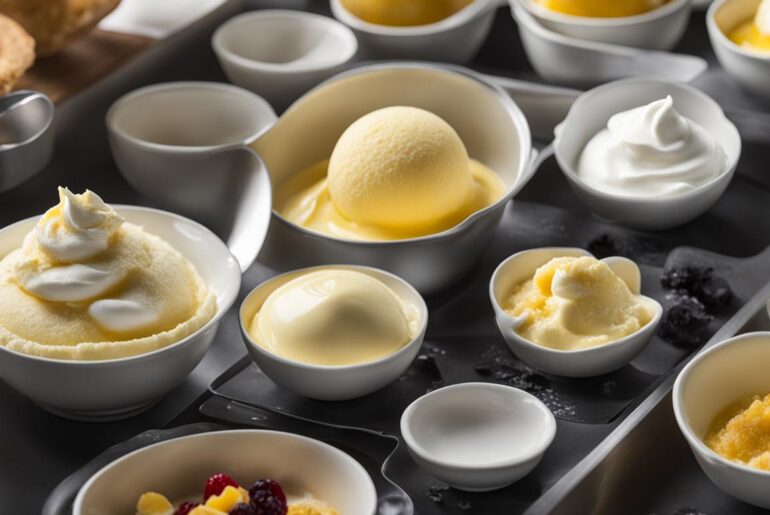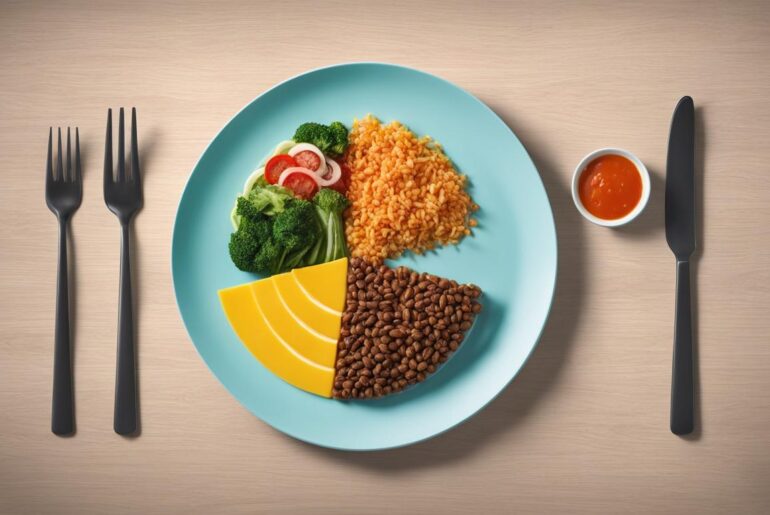Obesity is a growing epidemic in the United States, and one of the key factors contributing to weight gain is portion sizes. Research has shown that larger portion sizes lead to overeating, making it essential to practice effective portion control for weight management and overall health.
In this article, I will share 9 tips that can help you control your portions effectively. By implementing these strategies, you can prevent overindulging and make healthier choices when it comes to your food and beverage consumption.
Key Takeaways:
- Controlling portion sizes is crucial for weight management and preventing overeating.
- Use smaller dinnerware to help reduce the amount of food you consume.
- Your plate can serve as a portion guide, with half filled with vegetables, a quarter with protein, and a quarter with complex carbs.
- Use your hands as a serving guide – a palm-sized portion for protein, a fist-sized portion for vegetables, and a cupped hand for high-carb foods.
- Practicing portion control can lead to numerous benefits, including weight management and healthier eating habits.
Use Smaller Dinnerware
Evidence suggests that the sizes of plates, spoons, and glasses can influence how much food someone eats. Using larger plates can make food appear smaller, leading to overeating. Studies have shown that people using larger bowls or serving spoons tend to eat more without being aware of the change in portion size. By swapping your usual dinnerware for smaller alternatives, you can reduce the amount of food you consume and prevent overeating. Most people feel just as full when they eat from a smaller dish.
Implementing smaller dinnerware is one of the effective portion control strategies (see my post here). When we use smaller plates, bowls, and utensils, our eyes perceive a more generous portion of food, making us feel satisfied. This visual trick can help prevent us from overeating.
“Using smaller dinnerware has been proven to be an effective way to control portion sizes. When we eat from smaller dishes, it tricks our mind into thinking we’re consuming more food, resulting in feeling just as full as when we eat from larger plates.”
By reducing the size of your plates and bowls, you can make portion control easier. This strategy is especially useful if you tend to eat larger quantities of food. Remember to choose smaller dinnerware options that are proportional to your dietary needs and preferences. Making this simple change can have a significant impact on your portion control efforts and overall eating habits.
Use Your Plate as a Portion Guide
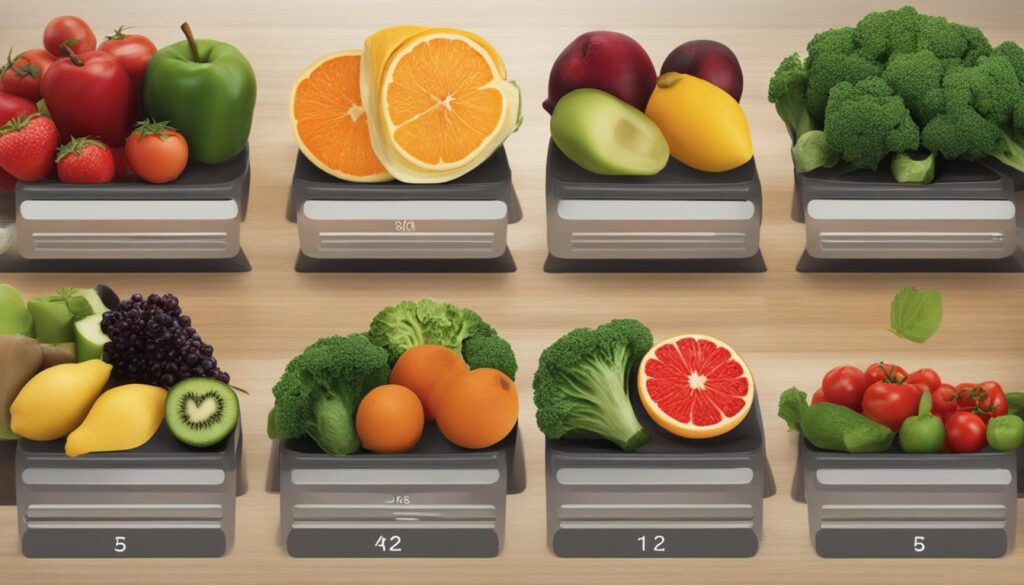
If measuring or weighing food isn’t appealing, you can use your plate as a guide for portion control. The general rule is to divide your plate into sections:
- Half should be filled with vegetables or salad.
- A quarter should contain high-quality protein like meat or tofu.
- Another quarter should consist of complex carbs like whole grains.
- Lastly, include a small amount of high-fat foods like cheese or oils.
This rough guide helps you create a well-balanced meal without needing to measure precisely. It ensures you have a good macronutrient ratio and a variety of nutrients on your plate. Remember to consider your individual dietary needs, as they may vary.
| Plate Section | Food Category |
|---|---|
| Half | Vegetables or Salad |
| A Quarter | High-Quality Protein (e.g., Meat, Tofu) |
| A Quarter | Complex Carbs (e.g., Whole Grains) |
| Small Amount | High-Fat Foods (e.g., Cheese, Oils) |
Use Your Hands as a Serving Guide
Another effective way to control portion sizes is by using your hands as a serving guide. The size of your hands usually corresponds to your body size, meaning that bigger individuals generally have larger hands and may require more food. This simple and intuitive method can help you estimate proper portion sizes without the need for measuring tools or complicated calculations.
Hand Size Guide:
Protein Foods: For protein-rich foods like meat or beans, a palm-sized serving is appropriate for women, while men may need two palm-sized portions. This guideline ensures that you consume an adequate amount of protein which is essential for muscle maintenance and overall health.
Vegetables and Salads: Aim for a fist-sized portion of vegetables and salads. Women should have one fist-sized portion, while men may require two fist-sized portions. Including plenty of vegetables in your meals adds bulk and nutrients without adding excessive calories.
High-Carb Foods: To determine the proper portion for high-carb foods like whole grains or starchy vegetables, use the cupped-hand method. Women should consume one cupped-hand portion, while men may need two. Whole grains provide important fiber and energy for your body’s needs.
High-Fat Foods: Limit high-fat foods, such as nuts or oils, to one thumb-sized portion for women and two for men. This helps control calorie intake while still allowing you to enjoy the benefits of healthy fats. Remember to choose unsaturated fats whenever possible.
Using your hands as a serving guide allows for a practical and visual approach to portion control. It’s a convenient way to estimate appropriate portion sizes wherever you are, whether at home, a restaurant, or on the go. Adjusting portion sizes based on individual needs and goals is essential for maintaining a balanced diet and managing weight effectively.
Next, I’ll discuss another effective portion control strategy: asking for half portions when eating out.
Conclusion
Practicing effective portion control is essential for weight management, preventing overeating, and fostering healthier eating habits. By implementing various portion control methods, individuals can take control of their food intake and improve their overall health (see my post here).
Using smaller dinnerware is a simple yet effective strategy. By swapping out larger plates and bowls for smaller ones, you can trick your mind into feeling satisfied with smaller portions. Research has shown that we tend to eat almost all of what we serve ourselves, so reducing the size of our dinnerware can help prevent the temptation to overindulge.
In addition to using smaller dinnerware, utilizing your plate or hands as portion guides can be practical and convenient. Dividing your plate into sections and filling it with a balance of vegetables, protein, complex carbs, and small amounts of high-fat foods can help create well-rounded and portion-controlled meals. Alternatively, using the portion sizes of your hands as a guideline can also ensure appropriate serving sizes for different food groups.
To further support portion control, there are additional lifestyle adjustments one can make. For instance, when dining out, asking for half portions or sharing meals can help avoid large servings. Starting meals with a glass of water, eating slowly, and avoiding eating directly from containers can also promote mindful eating and prevent excessive consumption.
Keeping track of your food intake through a food diary can provide valuable insights into portion sizes and help identify areas for improvement. By being aware of suitable serving sizes and making conscious choices, you can successfully control your portion sizes and achieve your health goals.
In conclusion, practicing portion control has numerous benefits, including weight management, prevention of overeating, and the cultivation of healthier eating habits. By implementing portion control methods and incorporating nutrient-dense foods into your diet, you can lead a healthier and more balanced lifestyle.

